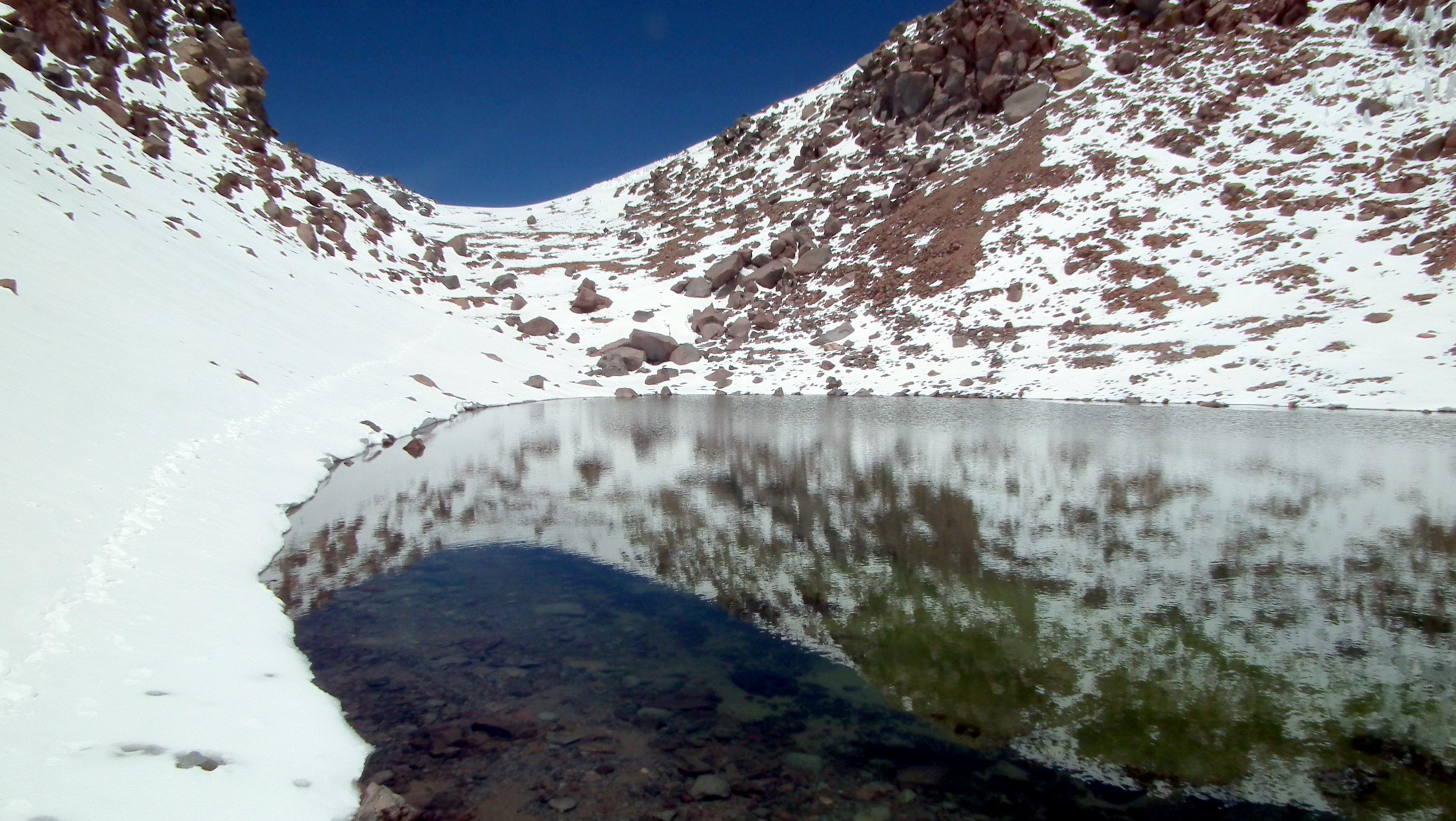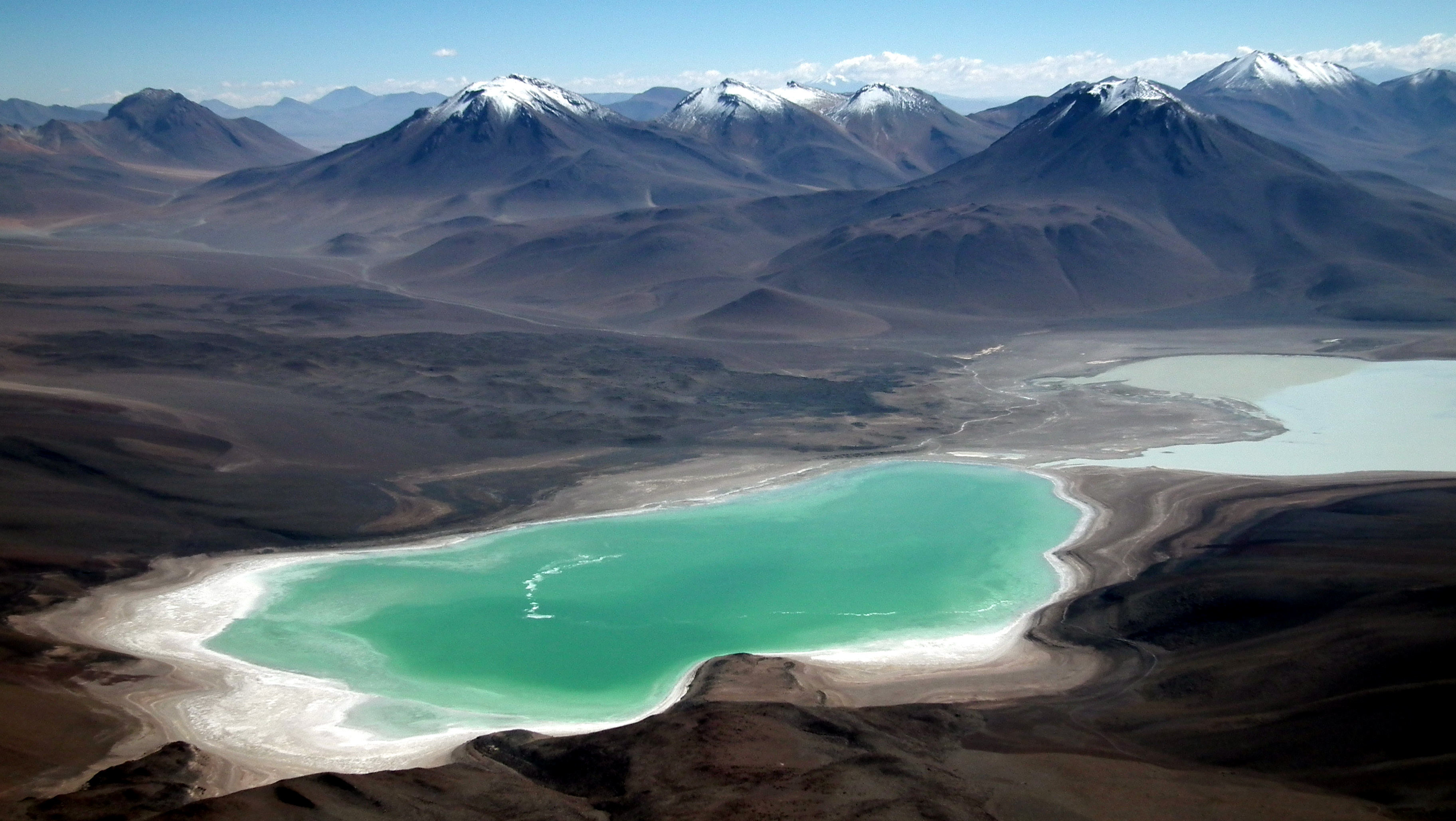|
Lake Licancabur
Licancabur Lake is a crater lake in Chile located on the volcano Licancabur ( Región de Antofagasta, Province of El Loa). It is close to the city San Pedro de Atacama and also very close to the border of Chile with Bolivia. The lake is among several high altitude volcanic lakes in the region. Licancabur Lake is located inside the summit crater of Licancabur and was discovered by climbers in 1953, when it was long. While the waterbody may have overflowed in the past, presently it is only drained by seepage and evaporation. Lake levels are variable; in 2002 it covered a surface area of . The lake's waters are clear and slightly saline. Temperature readings recorded at the lake bottom in 2006 suggest it is subject to geothermal heating. The local climate is arid, cold and subject to strong insolation, including strong ultraviolet radiation. This has caused the lake to be compared to the environment of Mars. Despite these conditions, bacteria, archaea, crustaceans and even a midg ... [...More Info...] [...Related Items...] OR: [Wikipedia] [Google] [Baidu] |
Licancabur
Licancabur () is a prominent, stratovolcano on the Bolivia–Chile border in the Central Volcanic Zone of the Andes. It is capped by a wide summit crater which contains Licancabur Lake, a Volcanic crater lake, crater lake that is among the highest lakes in the world. There are no glaciers owing to the arid climate. Numerous plants and animal species live on the mountain. The volcanoes Sairecabur and Juriques are north and east of Licancabur, respectively. Licancabur formed on top of ignimbrites produced by other volcanoes and it has been active during the Holocene. Three stages of lava flows emanated from the edifice and have a young appearance. Although no historical eruptions of the volcano are known, lava flows extending into Laguna Verde (Bolivia), Laguna Verde have been dated to 13,240 ± 100 before present and there may be residual heat in the mountain. The volcano has primarily erupted andesite, with small amounts of dacite and basaltic andesite. Several archaeological ... [...More Info...] [...Related Items...] OR: [Wikipedia] [Google] [Baidu] |
Crustacean
Crustaceans (from Latin meaning: "those with shells" or "crusted ones") are invertebrate animals that constitute one group of arthropods that are traditionally a part of the subphylum Crustacea (), a large, diverse group of mainly aquatic arthropods including decapods (shrimps, prawns, crabs, lobsters and crayfish), seed shrimp, branchiopods, fish lice, krill, remipedes, isopods, barnacles, copepods, opossum shrimps, amphipods and mantis shrimp. The crustacean group can be treated as a subphylum under the clade Mandibulata. It is now well accepted that the hexapods (insects and entognathans) emerged deep in the Crustacean group, with the completed pan-group referred to as Pancrustacea. The three classes Cephalocarida, Branchiopoda and Remipedia are more closely related to the hexapods than they are to any of the other crustaceans ( oligostracans and multicrustaceans). The 67,000 described species range in size from '' Stygotantulus stocki'' at , to the Japanese ... [...More Info...] [...Related Items...] OR: [Wikipedia] [Google] [Baidu] |
Atacameno
The Atacama people, also called Atacameño, are an Indigenous people from the Atacama Desert and altiplano region in the north of Chile and Argentina and southern Bolivia, mainly the Antofagasta Region. According to the Argentinean Census in 2010, 13,936 people identified as first-generation Atacameño in Argentina, while Chile was home to 21,015 Atacameño people as of 2002.2002 Chilean census Instituto nacional de estadisticas de Chile retrieved on May 17, 2015 Other names include Kunza and Likanantaí. History The origins of Atacameño culture can be traced back to 500 AD. The |
Sacred Mountains
Sacred mountains are central to certain religions, and are usually the subjects of many legends. For many, the most symbolic aspect of a mountain is the peak because it is believed that it is closest to heaven or other religious realms. Many religions have traditions centered on sacred mountains, which either are or were considered holy (such as Mount Olympus in Greek mythology) or are related to famous events (like Mount Sinai in Judaism and descendant religions or Mount Kailash, Mount Meru in Hinduism). In some cases, the sacred mountain is purely mythical, like the Hara Berezaiti in Zoroastrianism. Mount Kailash is believed to be the abode of the deities Shiva and Parvati, and is considered sacred in four religions: Hinduism, Bon, Buddhism, and Jainism. Volcanoes, such as Mount Etna in Italy, were also considered sacred, Mount Etna being believed to have been the home of Vulcan (mythology), Vulcan, the Roman mythology, Roman god of fire and the forge. Themes of sacrality Edwi ... [...More Info...] [...Related Items...] OR: [Wikipedia] [Google] [Baidu] |
Laguna Verde (Bolivia)
__NOTOC__ Laguna Verde (Spanish for "green lake") is a salt lake in an endorheic basin, in the southwestern Altiplano in Bolivia. It is located in the Sur Lípez Province of the Potosí Department. It is close to the Chilean border, at the foot of the volcano Licancabur. Geography The Laguna Verde is a lake at elevation. It covers an area of and has a depth of , and a narrow causeway divides it into two parts. It is at the southwestern extremity of the Eduardo Avaroa Andean Fauna National Reserve and Bolivia itself. It has mineral suspensions of arsenic and other minerals which renders colour to the lake waters. Its color varies from turquoise to dark emerald depending on the disturbance caused to sediments in the lake by winds. In the backdrop of the lake there is the inactive volcano Licancabur of in elevation, which is a nearly perfect cone. The shorelines west and east of the lake have different characteristics, with the western and southern shores eroded into volcanoes ... [...More Info...] [...Related Items...] OR: [Wikipedia] [Google] [Baidu] |
Laguna Blanca (Bolivia)
__NOTOC__ Laguna Blanca is a salt lake in an endorheic basin, in the Sur Lípez Province of the Potosí Department, Bolivia. It is near the Licancabur volcano. Geography The lake is at an elevation of on the Altiplano. Its surface area is 10.9 km2. The lake is long and wide. The characteristic white colour of the water, that gave the lake its name, is caused by the high amount of minerals suspended in it. Only a narrow corridor separates Laguna Blanca from the smaller Laguna Verde (Bolivia), Laguna Verde. Both are within the Eduardo Avaroa Andean Fauna National Reserve. In the past, Laguna Blanca was much larger; at least 45 meters higher than today and extending far east past its current shore. Having reached a peak water level 13,240 years before the present, Laguna Verde was then merged with Laguna Blanca. See also *Laguna Verde (Bolivia) — a salt lake also in Eduardo Avaroa Andean Fauna National Reserve *Laguna Colorada — a nearby salt lake notable for its red ... [...More Info...] [...Related Items...] OR: [Wikipedia] [Google] [Baidu] |
Pleistocene
The Pleistocene ( ; referred to colloquially as the ''ice age, Ice Age'') is the geological epoch (geology), epoch that lasted from to 11,700 years ago, spanning the Earth's most recent period of repeated glaciations. Before a change was finally confirmed in 2009 by the International Union of Geological Sciences, the cutoff of the Pleistocene and the preceding Pliocene was regarded as being 1.806 million years Before Present (BP). Publications from earlier years may use either definition of the period. The end of the Pleistocene corresponds with the end of the last glacial period and also with the end of the Paleolithic age used in archaeology. The name is a combination of Ancient Greek () 'most' and (; Latinized as ) 'new'. The aridification and cooling trends of the preceding Neogene were continued in the Pleistocene. The climate was strongly variable depending on the glacial cycle, oscillating between cold Glacial period, glacial periods and warmer Interglacial, int ... [...More Info...] [...Related Items...] OR: [Wikipedia] [Google] [Baidu] |
Frontier
A frontier is a political and geographical term referring to areas near or beyond a boundary. Australia The term "frontier" was frequently used in colonial Australia in the meaning of country that borders the unknown or uncivilised, the boundary, border country, the borders of civilisation, or as the land that forms the furthest extent of what was frequently termed "the inside" or "settled" districts. The "outside" was another term frequently used in colonial Australia, this term seemingly covered not only the frontier but the districts beyond. Settlers at the frontier thus frequently referred to themselves as "the outsiders" or "outside residents" and to the area in which they lived as "the outside districts". At times one might hear the "frontier" described as "the outside borders". However the term "frontier districts" was seemingly used predominantly in the early Australian colonial newspapers whenever dealing with skirmishes between black and white in northern New S ... [...More Info...] [...Related Items...] OR: [Wikipedia] [Google] [Baidu] |
Volcano
A volcano is commonly defined as a vent or fissure in the crust of a planetary-mass object, such as Earth, that allows hot lava, volcanic ash, and gases to escape from a magma chamber below the surface. On Earth, volcanoes are most often found where tectonic plates are diverging or converging, and because most of Earth's plate boundaries are underwater, most volcanoes are found underwater. For example, a mid-ocean ridge, such as the Mid-Atlantic Ridge, has volcanoes caused by divergent tectonic plates whereas the Pacific Ring of Fire has volcanoes caused by convergent tectonic plates. Volcanoes resulting from divergent tectonic activity are usually non-explosive whereas those resulting from convergent tectonic activity cause violent eruptions."Mid-ocean ridge tectonics, volcanism and geomorphology." Geology 26, no. 455 (2001): 458. https://macdonald.faculty.geol.ucsb.edu/papers/Macdonald%20Mid-Ocean%20Ridge%20Tectonics.pdf Volcanoes can also form where there is str ... [...More Info...] [...Related Items...] OR: [Wikipedia] [Google] [Baidu] |
Scuba Dive
Scuba diving is a mode of underwater diving whereby divers use breathing equipment that is completely independent of a surface breathing gas supply, and therefore has a limited but variable endurance. The word ''scuba'' is an acronym for "Self-Contained Underwater Breathing Apparatus" and was coined by Christian J. Lambertsen in a patent submitted in 1952. Scuba divers carry their own source of breathing gas, affording them greater independence and movement than surface-supplied divers, and more time underwater than freedivers. Although the use of compressed air is common, other gas blends are also used. Open-circuit scuba systems discharge the breathing gas into the environment as it is exhaled and consist of one or more diving cylinders containing breathing gas at high pressure which is supplied to the diver at ambient pressure through a diving regulator. They may include additional cylinders for range extension, decompression gas or emergency breathing gas. Closed ... [...More Info...] [...Related Items...] OR: [Wikipedia] [Google] [Baidu] |
High Lakes Project
High may refer to: Science and technology * Height * High (atmospheric), a high-pressure area * High (computability), a quality of a Turing degree, in computability theory * High (tectonics), in geology an area where relative tectonic uplift took or takes place * Substance intoxication, also known by the slang description "being high" * Sugar high, a misconception about the supposed psychological effects of sucrose Music Performers * High (musical group), a 1974–1990 Indian rock group * The High, an English rock band formed in 1989 Albums * ''High'' (The Blue Nile album) or the title song, 2004 * ''High'' (Flotsam and Jetsam album), 1997 * ''High'' (New Model Army album) or the title song, 2007 * ''High'' (Royal Headache album) or the title song, 2015 * ''High'' (Keith Urban album), 2024 * ''High'' (EP), by Jarryd James, or the title song, 2016 Songs * "High" (Alison Wonderland song), 2018 * "High" (The Chainsmokers song), 2022 * "High" (The Cure song), 1992 * "Hi ... [...More Info...] [...Related Items...] OR: [Wikipedia] [Google] [Baidu] |







